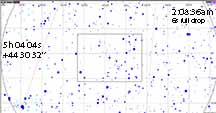


This is a good bright star, full drop from mag 10.9 for 6 seconds, decent rank, and the southern limit clips Santa Cruz. Karl's got the best site. I plan to try it from the top of Rodeo Gulch Rd. But, it's at 2am on a weekday, which is unfortunate. It's a good event, and there are 6 observers signed up, as it also crosses Arizona.
 |
 |
 |
We had significant cirrus clouds. Karl was clouded out. I was at the top of Rodeo Gulch and the clouds got thinner as the recording went on. I got a 2sec event, I believe, but it was 6s late. I've sent my .avi on to Tony George via WeTransfer, and he'll try his luck at it. Kirk looks like a miss, as would be expected if I had a 2s event on a 6s predicted maximum... I must have been very close to the southern limit.
Richard Nolthenius
Tony George re-analyzed my tape, using a comparison star to help normalize the cloud trouble, and found event timings very similar to my own. We'll use his analysis for the report to IOTA. His commentary: I ran the light curve backwards from the brightest end of the video down to frame 1001, which eliminated much of the video that was in the crud. I then analyzed the light curve in PyOTE. I normalized the light curve to the brightest star that I used for tracking. I was able to find an event that passed the PyOTE False Positive test (easily). My files are attached. I’ll leave it to you and Kirk to sort out his results, unless he wants me to look at his video as you did. For a verification that this is truly an event, I ran the PyOTE Detectability routine [results are at the end of the .log file]. It shows that a 5.9 mag drop event should be detectable in your light curve for an event as short as 0.9 seconds. The event I derived from your light curve was 1.8 seconds [which is why it passed the False Positive test].
 |
 |
 |
 |
Tony's PyOTE log file for RN's data and the log file from my reductions for comparison. Tony submitted these results to me and also to John Moore, so once I submit the IOTA report now, it's done.
Kirk Bender
Tony George re-analyzed Kirk's .avi raw tape with the following judgment on the recording..... You can see the field is crowded with stars. The target star image is lopsided, so there could be a star hidden there. Unfortunately, without other corroborating observations showing a similar drop in a similar time frame compared to the primary event detected by Richard, I don’t see any way this event can be reported, other than as a possible double star. Another issue is the event detected does not pass the PyOTE False Positive test. Therefore, there is the potential that the event could be due to noise. I did an event detectability analysis of your light curve with PyOTE. With the degree of noise in your light curve, you should have been able to see a primary (5.9 mag drop) event if it was 0.3 seconds or longer. Yours is clearly longer, so clearly not the primary event. I then tested for the 0.5 mag drop detected in your event. For such a mag drop to be detectable with the degree of noise in your light curve, it would have to be 1.4 seconds or longer. The event I detected in your light curve was 1.0 seconds. So, to me, it looks like a noise-caused event.
The DAMIT solution from photometry supports that this was a miss, although there's a small chance the star might have been a binary with only one component occulted by Kirk(?).
 |
 |
 |
 |
Tony's Pyote LOG file for Kirk's data